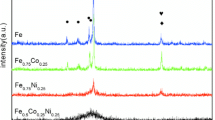Abstract
Continuing the earlier experiments, a series of new effects will be presented in this paper which demonstrate, that the amorphous Curie temperature (T amC ) can be altered by resting the samples at low temperature such as (liquid N2, 77 K). The sign and magnitude of this shift depends on the alloy composition, but can also be influenced by the rate of liquid quench applied during the ribbon formation. T amC is lowered during liquid N2 treatments for the binary Fe85B15 glass. The effect is the same when a small amount of Si is added to the Fe85B15. Exceeding the critical concentration limit of the Si, the sign of T amC changes.
Similar content being viewed by others
Author information
Authors and Affiliations
Rights and permissions
About this article
Cite this article
Bán, K., Lovas, A. & Kováč, J. Cryogenic Effects in the Amorphous Curie Temperature Shift of Fe-based Glassy Alloys. Czech J Phys 54 (Suppl 4), 141–144 (2004). https://doi.org/10.1007/s10582-004-0049-8
Issue Date:
DOI: https://doi.org/10.1007/s10582-004-0049-8




